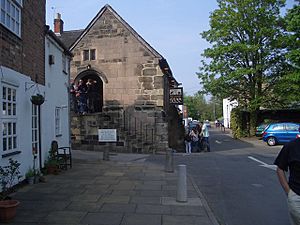Scheduled monuments in Derby facts for kids
A scheduled monument is a really important old place or building in the United Kingdom. It's like a special list that protects these sites from being changed without permission. Imagine it as a way to keep history safe!
These special places are chosen by the government's Secretary of State for Culture, Media and Sport. An organization called English Heritage helps find and identify these sites. There are about 20,000 scheduled monuments across the UK, and English Heritage looks after this list. Sometimes, one entry on the list can even include more than one historical site.
While a scheduled monument can also be called a "listed building," English Heritage often thinks that being a listed building is an even better way to protect old buildings. If a monument isn't considered important enough anymore, it can be removed from the list.
Derbyshire, the county where Derby is, has over 500 scheduled monuments! These include ancient stone piles called cairns, mysterious stone circles, old burial mounds called barrows, remains from lead mining, ancient settlements, and more than 20 old bridges.
Contents
What Are Derby's Scheduled Monuments?
The City of Derby is home to several fascinating scheduled monuments. These sites give us clues about how people lived long ago, from Roman times to the medieval period. Let's explore some of them!
Ancient Cross in Spondon
In the churchyard of St Werburgh's Church, Spondon, you can find the remaining part of an ancient cross. This stone pillar, called a high cross shaft, dates all the way back to the 9th century! It's made of limestone and is a reminder of early Anglo-Scandinavian history in the area. The top part of the cross is now missing, but the shaft still stands as a historical marker.
Darley Abbey's Old Church
Darley Abbey holds the remains of an old Augustinian abbey. An abbey was a type of monastery where monks lived and worshipped. This one was started around 1146 by a person named Robert de Ferrers, 2nd Earl of Derby. It was closed down in 1538. Today, the only building left from the original abbey is a hall house, which has been turned into The Abbey pub. It's cool to think you can visit a place that was once part of an ancient abbey!
Roman Life at Derby Racecourse
Imagine Romans living right where Derby Racecourse is today! This area was once a Roman civilian settlement with a cemetery. It was located along a Roman road that connected the Roman fort at Little Chester (which they called Derventio) to the River Trent at Sawley. This site helps us understand how Romans lived outside their forts.
Littlechester Roman Fort Site
The area known as Littlechester was once the site of the important Roman fort, Derventio Coritanorum. This fort was a key military base for the Romans in the region. While much of the original Roman site is now hidden beneath modern houses and gardens, it remains a scheduled monument. This means it's protected, even if we can't see all of it easily.
Roman Bath House at Parker's Piece
Close to the old Roman fort of Derventio, buried remains of a Roman bath house were found in 1924 at Parker's Piece. Roman bath houses were like ancient spas, where people would go to clean themselves, exercise, and socialize. Finding these remains helps archaeologists learn more about the daily lives of the Romans who lived in Derby.
Rykneld Street Roman Road
A short section of the ancient Roman road called Rykneld Street is also a scheduled monument near Littleover. This road was an important route for the Romans, connecting places like Wall at Litchfield to the fort at Derventio. Along with the road, remains of a Bronze Age cemetery have also been found here, showing that people lived in this area even before the Romans arrived.
St Mary's Bridge
St Mary's Bridge in Derby is another protected monument. This bridge was built between 1788 and 1793 by a person named Thomas Harrison. It replaced an even older medieval bridge that was taken down. St Mary's Bridge has three arches and crosses over the River Derwent. It's a great example of 18th-century engineering.


